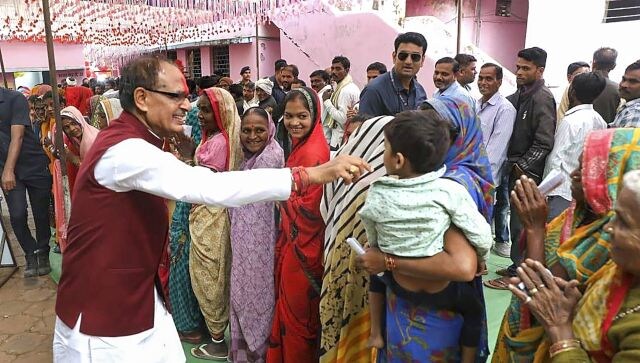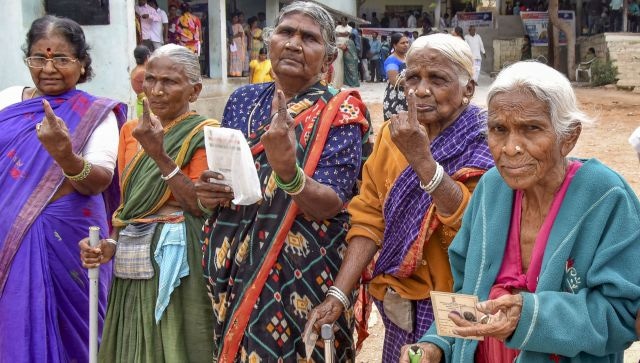It is election season in India. On Thursday, predictions of the results of the just concluded state Assembly elections will be out. Will Congress be able to retain power in Rajasthan? Will Madhya Pradesh pick the BJP again? What can we expect in Telangana, Chhatisgarh and Mizoram? While the final results for the five Assembly elections will be declared on 3 December, Thursday’s exit poll predictions give a sneak peek into the voting trends and the possible outcomes. The exit polls reflect the public sentiment.
Telangana
is the last state to go to polls, where voting continues until 6 pm Thursday. The exit polls for the five states started coming in only after 6.30 pm. How are exit polls conducted? And how accurate are they? Let’s take a closer look: What are exit polls? Exit polls are basically voter surveys that are conducted as they exit their polling booths – hence the name. These are different from opinion polls, which are held prior to elections. The point of an exit poll is to predict which party is likely to take power and with how many seats. The logic behind exit polls is that if you ask voters such questions right outside the polling booth, their memory is fresh and they are likely to tell you the truth. According to The Indian Express, the Indian Institute of Public Opinion conducted an exit poll during the second Lok Sabha elections in 1957. However, serious media poll surveys started surfacing in the 1980s, with psephologist Prannoy Roy partnering up with David Butler. Their studies culminated in the book “The Compendium of Indian Elections” by Prannoy Roy, David Butler and Ashok Lahiri, reports Business Standard. How are exit polls conducted? Each polling group basically has its own technique and sample size – there’s no one-size-fits-all method of conducting exit polls. Exit polls can either be conducted in person or online. Sanjay Kumar, director of the Centre for the Study of Developing Societies, wrote in The Indian Express, “Without a structured questionnaire, the data can neither be collected coherently nor be analysed systematically to arrive at vote share estimates.” [caption id=“attachment_13449922” align=“alignnone” width=“640”] Madhya Pradesh chief minister Shivraj Singh Chouhan meets voters after casting his vote for the state Assembly elections, in Sehore district on 17 November. The exit polls will predict if the BJP will retain power in the state. PTI[/caption] However, it is important to note that Section 126A of the Representation of the People’s Act, 1951, bans exit polls from the beginning of the voting until a half hour after the final phase of voting has been held. “No person shall conduct any exit poll and publish or publicise by means of the print or electronic media… the result of any exit poll during such period… In case of a general election, the period may commence from the beginning of the hours fixed for the poll on the first day of poll and continue till half an hour after closing of the poll in all the states and union territories,” the law states. It also mandates a two-year prison term or fine or both for anyone violating this statute. What do the exit polls predict? After the voting concluded in Telangana at 6 pm, the exit polls for the five states,
Madhya Pradesh
,
Rajasthan
, Telangana,
Chhattisgarh
and
Mizoram
, were declared, starting from 6.30 pm. [caption id=“attachment_13449932” align=“alignnone” width=“640”]
Madhya Pradesh chief minister Shivraj Singh Chouhan meets voters after casting his vote for the state Assembly elections, in Sehore district on 17 November. The exit polls will predict if the BJP will retain power in the state. PTI[/caption] However, it is important to note that Section 126A of the Representation of the People’s Act, 1951, bans exit polls from the beginning of the voting until a half hour after the final phase of voting has been held. “No person shall conduct any exit poll and publish or publicise by means of the print or electronic media… the result of any exit poll during such period… In case of a general election, the period may commence from the beginning of the hours fixed for the poll on the first day of poll and continue till half an hour after closing of the poll in all the states and union territories,” the law states. It also mandates a two-year prison term or fine or both for anyone violating this statute. What do the exit polls predict? After the voting concluded in Telangana at 6 pm, the exit polls for the five states,
Madhya Pradesh
,
Rajasthan
, Telangana,
Chhattisgarh
and
Mizoram
, were declared, starting from 6.30 pm. [caption id=“attachment_13449932” align=“alignnone” width=“640”] Voters show their fingers marked with indelible ink after casting their votes for the Telangana Assembly elections, in Hyderabad, on 30 November. The exit polls are out now that the voting closed in the state at 6 pm. PTI[/caption] Five exit polls suggest that Ashok Gehlot will be out of power in Rajasthan. The BJP and the Congress are in a tight race in Madhya Pradesh. While the Congress is ahead in Chhattisgarh, the BJP is close behind, say exit polls, according to a report on NDTV. The Congress appeared to be ahead in Telangana. Exit polls indicate a clear lead for the party over its rival Bharat Rashtra Samithi (BRS), the party of Chief Minister K Chandrasekhar Rao (KCR). There is no clear winner in Mizoram so far. Two exit polls predict a hung assembly. Have exit polls always been accurate? The accuracy of exit polls has been the subject of much debate from experts, politicians and academics. Some take issue with the way questions are phrased, the methodology used, sample size, the demographic and economic factors. Others accuse their rivals of having a hand in the exit polls and say such polls miss out on the ‘silent voters’. The Chanakya exit poll, C-Voter exit poll and MyAxis exit poll are some of today’s prominent pollsters. Exit polls have got it wrong on several occasions. The exit polls released by various leading agencies on 10 May this year showed that Karnataka might have a hung assembly with Congress as the largest party. Two predicted an outright victory for the Congress and one for the BJP. The Grand Old Party secured a victory in Karnataka defeating the BJP which was in power. A big miss came in West Bengal in 2021 where pollsters predicted the BJP to take power. Instead, it was the Trinamool Congress that came out on top once again with 213 seats while the BJP bagged 77 seats. In 2020, the Rashtriya Janata Dal-led coalition was expected to take power but the it was BJP-JD(U) alliance that ultimately prevailed. In 2017, the BJP was predicted to come to power in Gujarat with 112 to 116 seats. Instead, the BJP found its tally at only 99 seats in the 182-member Assembly. In Uttar Pradesh that same year, all pollsters predicted a hung Assembly with the BJP emerging as the single-largest party in India’s most populous state. Instead, the BJP and its allies absolutely demolished the Opposition – winning a massive 312 seats in the 403-seat Assembly. In the 2014 Lok Sabha polls, though most pollsters favoured the Narendra Modi-led NDA to take power, few accounted for the scale of their victory – a massive 336 seats. Arguably the nadir of exit polls came in 2004 when the Atal Bihari Vajpayee-led NDA dispensation, pushing the ‘India Shining’ narrative, was predicted to return to power with a majority. Instead, the Congress-led UPA won 225 seats compared to the NDA’s 189 seats. With inputs from agencies Read all the
Latest News
,
Trending News
,
Cricket News
,
Bollywood News
, India News
and
Entertainment News
here. Follow us on
Facebook
,
Twitter
and
Instagram
.
Voters show their fingers marked with indelible ink after casting their votes for the Telangana Assembly elections, in Hyderabad, on 30 November. The exit polls are out now that the voting closed in the state at 6 pm. PTI[/caption] Five exit polls suggest that Ashok Gehlot will be out of power in Rajasthan. The BJP and the Congress are in a tight race in Madhya Pradesh. While the Congress is ahead in Chhattisgarh, the BJP is close behind, say exit polls, according to a report on NDTV. The Congress appeared to be ahead in Telangana. Exit polls indicate a clear lead for the party over its rival Bharat Rashtra Samithi (BRS), the party of Chief Minister K Chandrasekhar Rao (KCR). There is no clear winner in Mizoram so far. Two exit polls predict a hung assembly. Have exit polls always been accurate? The accuracy of exit polls has been the subject of much debate from experts, politicians and academics. Some take issue with the way questions are phrased, the methodology used, sample size, the demographic and economic factors. Others accuse their rivals of having a hand in the exit polls and say such polls miss out on the ‘silent voters’. The Chanakya exit poll, C-Voter exit poll and MyAxis exit poll are some of today’s prominent pollsters. Exit polls have got it wrong on several occasions. The exit polls released by various leading agencies on 10 May this year showed that Karnataka might have a hung assembly with Congress as the largest party. Two predicted an outright victory for the Congress and one for the BJP. The Grand Old Party secured a victory in Karnataka defeating the BJP which was in power. A big miss came in West Bengal in 2021 where pollsters predicted the BJP to take power. Instead, it was the Trinamool Congress that came out on top once again with 213 seats while the BJP bagged 77 seats. In 2020, the Rashtriya Janata Dal-led coalition was expected to take power but the it was BJP-JD(U) alliance that ultimately prevailed. In 2017, the BJP was predicted to come to power in Gujarat with 112 to 116 seats. Instead, the BJP found its tally at only 99 seats in the 182-member Assembly. In Uttar Pradesh that same year, all pollsters predicted a hung Assembly with the BJP emerging as the single-largest party in India’s most populous state. Instead, the BJP and its allies absolutely demolished the Opposition – winning a massive 312 seats in the 403-seat Assembly. In the 2014 Lok Sabha polls, though most pollsters favoured the Narendra Modi-led NDA to take power, few accounted for the scale of their victory – a massive 336 seats. Arguably the nadir of exit polls came in 2004 when the Atal Bihari Vajpayee-led NDA dispensation, pushing the ‘India Shining’ narrative, was predicted to return to power with a majority. Instead, the Congress-led UPA won 225 seats compared to the NDA’s 189 seats. With inputs from agencies Read all the
Latest News
,
Trending News
,
Cricket News
,
Bollywood News
, India News
and
Entertainment News
here. Follow us on
Facebook
,
Twitter
and
Instagram
.
2023 Assembly elections: How are exit polls conducted? Are they accurate?
FP Explainers
• November 30, 2023, 18:59:56 IST
The exit polls predicting the results of the elections in five states – Madhya Pradesh, Rajasthan, Telangana, Chhattisgarh and Mizoram – are out. What are these polls and are they foolproof?
Advertisement
)
End of Article